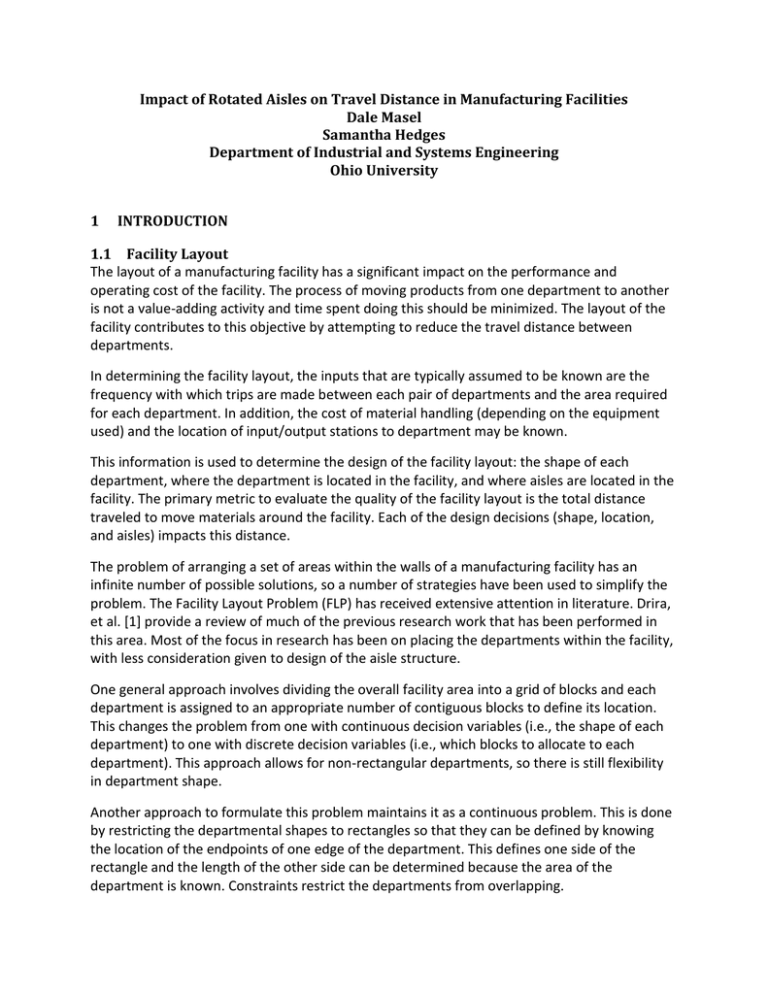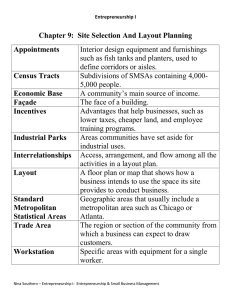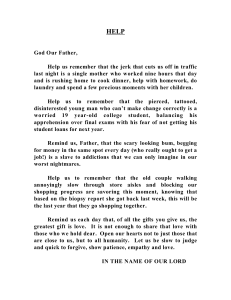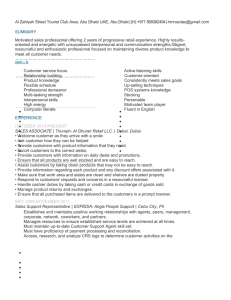Impact of Rotated Aisles on Travel Distance in Manufacturing Facilities
advertisement

Impact of Rotated Aisles on Travel Distance in Manufacturing Facilities Dale Masel Samantha Hedges Department of Industrial and Systems Engineering Ohio University 1 INTRODUCTION 1.1 Facility Layout The layout of a manufacturing facility has a significant impact on the performance and operating cost of the facility. The process of moving products from one department to another is not a value-adding activity and time spent doing this should be minimized. The layout of the facility contributes to this objective by attempting to reduce the travel distance between departments. In determining the facility layout, the inputs that are typically assumed to be known are the frequency with which trips are made between each pair of departments and the area required for each department. In addition, the cost of material handling (depending on the equipment used) and the location of input/output stations to department may be known. This information is used to determine the design of the facility layout: the shape of each department, where the department is located in the facility, and where aisles are located in the facility. The primary metric to evaluate the quality of the facility layout is the total distance traveled to move materials around the facility. Each of the design decisions (shape, location, and aisles) impacts this distance. The problem of arranging a set of areas within the walls of a manufacturing facility has an infinite number of possible solutions, so a number of strategies have been used to simplify the problem. The Facility Layout Problem (FLP) has received extensive attention in literature. Drira, et al. [1] provide a review of much of the previous research work that has been performed in this area. Most of the focus in research has been on placing the departments within the facility, with less consideration given to design of the aisle structure. One general approach involves dividing the overall facility area into a grid of blocks and each department is assigned to an appropriate number of contiguous blocks to define its location. This changes the problem from one with continuous decision variables (i.e., the shape of each department) to one with discrete decision variables (i.e., which blocks to allocate to each department). This approach allows for non-rectangular departments, so there is still flexibility in department shape. Another approach to formulate this problem maintains it as a continuous problem. This is done by restricting the departmental shapes to rectangles so that they can be defined by knowing the location of the endpoints of one edge of the department. This defines one side of the rectangle and the length of the other side can be determined because the area of the department is known. Constraints restrict the departments from overlapping. Both formulations typically ignore the location of aisles in the facility and calculate travel based on the rectilinear distance between departments (where the location of a department is defined by its centroid). When aisles for interdepartmental travel are placed, they are typically assumed to run along the borders of the departments, which are parallel to the walls of the facility. 1.2 Rotated Aisles Although almost all facilities have aisles that run parallel to the walls, this is not structurally necessary. Rotating the aisles so that they are not parallel to the walls of the facility requires some additional considerations such as acute angles at some intersections (which can require lift truck operators to slow further to make the turn) and positioning with respect to the support columns in the facility. However, previous research has shown how rotated aisles can reduce travel distance in a warehouse (Gue and Meller, 2009) with further work conducted to develop the optimal facility layout with rotated aisles (Pohl, et al., 2009; Oztürkoglu, et al., 2012). Rotated aisles can also have benefits in a manufacturing facility, but implementing them has lower opportunities for reducing travel distance and additional complications in setting up the layout, as compared to warehouses. There is reduced potential for benefits with rotated aisles because of the nature of travel in a manufacturing facility. In a warehouse, rotated aisles have primarily been examined for use in a unit load warehouse, where lift trucks move one pallet at a time to or from a single input/output (I/O) location that represents the receiving/shipping area. In dual-command operations (where operators drop off a pallet at one location, then travel to another location to pick up a pallet before returning to the I/O point) there may be some travel within the facility, but the primary travel is still to/from a single point. In contrast, a manufacturing facility typically does not have a single point where most travel begins or ends. Parts must visit multiple departments in the facility and may follow different routes depending on processing requirements. In addition, the location of the departments has often been set to minimize the length of frequently traveled routes, so even if rotating the aisles results in a shorter path, it is reducing the length of an already short trip. The main complication in rotating aisles for a manufacturing facility is that the departments in a manufacturing facility are represented as areas, so the shape of the department is dependent on the angles of the aisles that form the departmental boundaries. (In contrast, the aisles of a warehouse are nearly lines, and can more easily be placed in the facility after rotated aisles are placed.) The methodology section will describe an approach to implement rotated aisles for a manufacturing facility that maintains the area of each department. The results section will evaluate the methodology for multiple layouts to demonstrate cases in which the rotated aisles will reduce expected travel distance. 2 LAYOUT METHODOLOGY 2.1 Assumptions In the layout, it is assumed that there are two main aisles which divide the layout into three sections. For the examples discussed in this paper, the main aisles will always appear vertically on the layout, but this is an arbitrary distinction in the layout and they could run horizontally. These main aisles will be the only ones that are rotated; the remaining aisles (and cell boundaries) will remain parallel to the facility walls. To begin the process of generating the layout, the number of trips between each pair of departments must be known and the size of each department must be known. It is also assumed that the location of the input/output point for each department is known. Travel distances will be calculated using these locations as the endpoints of the path. Typically, the centroid for a department area is used as the endpoint of the travel path. However, this isn’t feasible when the main aisles are rotated. Because all travel will not be rectilinear, the point at which a path joins the rotated aisles will affect the distance. This is shown in Figure 1. The shortest path between the two centroids (shown as circles) must pass through the two intersections marked with squares, but there are two ways to reach each intersection from the associated centroid and these paths have different lengths. Figure 1: Examples of paths for rotated aisles It will be assumed that the I/O point for each department is located on one of the main aisles, so the distance to the main aisle is zero. The I/O points could also be located on the horizontal aisles since there would only one route to the main aisle, but for calculation simplicity, they will be restricted to the main aisles. 2.2 Layout Generation The block layout methodology described previously depends on having blocks that are equal size and shape. If the aisles are rotated, the shape of each block will no longer be the same. This would mean that either the layout of each department can no longer be defined as a discrete number of blocks or that there will be aisles running through the middle of the department, which is undesirable. The approach of defining just one edge of the department also can’t be used because it depends on having rectangular departments, so that the length of one side of the department can be calculated from knowing only the department area and the length of the other side. However, this method can be modified for use with rotated aisles, as described below. The method begins by creating a layout for the departments that produces one or more main aisles (which are assumed in this paper to be vertical) that run across the facility. Alagoz, et al. (2008) describe one such method. In this paper, it will be assumed that there are always two main aisles, but the methodology could be used for more main aisles. The departments can also be placed as blocks without consideration of size, such as the layout shown in Figure 2. After they are placed relative to each other, the blocks can be expanded to the appropriate size, which determines the size of each section. Figure 2: Example of department arrangement As described previously, the facility is divided into three sections by the two main aisles, as shown in Figure 3. x1 A1 x'10 A2 A3 y A'1 A'2 θ1 A'3 θ3 x'1n1 (a) (b) Figure 3: Layout divided into 3 sections with (a) Traditional aisles; (b) Rotated aisles All calculations assume that the aisles occupy no area. This simplification will result is some of the space in the departments being lost to aisles, since the rotated main aisle (which is longer than the corresponding traditional main aisle) will require more floor space. 2.3 Calculating Department Dimensions In Figure 3a, the width of each department in section i is the same (xi), but in Figure 3b the width varies from department to department. In section i, the width of the bottom boundary of the jth department is xij and the width of the top boundary of the jth department is xij-1. There are ni departments assigned to section i. The area of section i can be determined based on which departments are assigned to that section: ∑ where, (1) aj = Area of department j zij = 1, if department j is assigned to section i = 0, otherwise n = Total number of departments in the facility The area of each section can be calculated: 123 (2) and 123 (3) The areas of the sections shouldn’t change when the main aisles are rotated, so Ai = A'i: 2 (4) The value of xi is known (=y/Ai), so either x’i0 or x’in must be known in order to determine the length of the other side of the department. The impact of the value chosen for length of the bottom edge of each section will be evaluated in the results. Once the length of the top and bottom edges of each section is known, the angle to which the aisle must be rotated can be calculated: n ( ) 13 (5) The main aisles are assumed to run at the same angle from one wall of the facility to the other, so that once the rotation of the main aisle is known, the appropriate height of each department in section i (i.e., y'i1, y'i2, …) can be determined to maintain the original area of the department (i.e., ai1, ai2, …). For the top department in section i: ( ) (6) where x’i1 is calculated as the length of x’i0 plus the added distance to the main aisle introduced by the angle of the main aisle. From equation (4), the value of x'i0 can be calculated based on values already known, leaving y’i1 as the only unknown. Applying the quadratic formula to equation (6) produces a formula for yi1: √ ( ( ) (7) ) The same formula can be used for i = 1, 2, 3; the only difference is that x20 is calculated based on the total length of the facility and the length of the top of the other two departments ( x10 and x30). The remaining departmental dimensions can be calculated iteratively; once the dimensions of the height and top edge of a department are known, the dimension of the bottom edge can be calculated so that the area of each department is maintained. 2.4 Calculating Travel Distances Once the dimensions of each department are known, the location of the I/O station for each department must be defined before the travel distance can be calculated. Travel within the department is ignored, so the I/O stations are assumed to be on one of the main aisles. A single location is used for items arriving at the department and items leaving the department; for consistency, it is assumed that this location is located at the midpoint of the department boundary that is adjacent to the main aisle. In calculating travel distance, it is assumed that all travel takes place along one of the main aisles, or one of the horizontal boundaries between the departments in the center section. It is also assumed that workers will take the shortest route possible, even if it requires backtracking. For example, for a trip from the upper-left-most department to the lower-right-most department, the shortest path (depending on angle of aisles and location of I/O stations) may involve taking the left main aisle all the way to the bottom of the layout, then going across to the other main aisle and back up the right main aisle to the I/O station, as shown in Figure 1. For departments that have their I/O station located on the same main aisle, the distance is calculated by measuring the distance along that main aisle: | | √ ( ) (8) where dij is the distance between departments i and j and syi and syj are the y-coordinates of the I/O stations of departments i and j. For departments with I/O stations on opposite main aisles, the path distance is calculated by taking the distance to each horizontal cross aisle for both of the I/O points and adding the length of the horizontal aisle. This is calculated for each of the n2 horizontal cross aisles, with the chosen route being the one with the shortest distance. (| | | |) √ ( ) 01 2 (9) The total distance traveled in a layout is typically used as a metric for evaluating the quality of a layout. The metric depends on the distance between departments i and j (dij) and the number of trips made between the departments in a given time period (fij), as shown in Equation 10: ∑ ∑ 3 (10) TESTING To evaluate the impact that rotating the main aisles has on travel distance, preliminary testing has been conducted on the change in total distance traveled when the main aisles are rotated. In the testing, it is assumed that the relative relationship of the departments doesn’t change when the aisles are rotated; the only change is the shape of the departments, which have the height changed to maintain the same area. Three problems were generated with different department areas and interdepartmental flows. Each problem contained 9 departments with 3 departments in each section. Layouts with traditional and rotated main aisles are shown in Figure 4. G A D F E I B H C (a) (b) Figure 4: Example of layouts with (a) Traditional main aisles; (b) Rotated main aisles In the testing, different values of x’23 (i.e, the bottom edge of section 2—the bottom of department H in Figure 4) were used to evaluate the impact of this parameter on the effectiveness of the angled aisles. The sides of sections 1 and 3 are assumed to be equal, so x’13 = x’33 = (x – x’23)/2 The results of the testing are shown in Figure 5. The chart shows that there are improvements over traditional aisles, but not in all cases. For each problem, there are dimensions for the bottom of Section 2 that produce a lower total distance than traditional aisles, but there are also dimensions that increase the total distance. 21000 20000 Total Distance 19000 Problem 1 18000 Problem 2 17000 Problem 3 16000 Traditional - P1 15000 Traditional - P2 14000 Traditional - P3 13000 0 20 40 60 80 Length at Bottom of Section 2 Figure 5: Total Travel Distance with Changes in Section Size The line that illustrates the relationship between the section 2 bottom length and the total distance shows a different shape for each problem: continuously increasing for problem 1; generally increasing for problem 2; and generally decreasing for problem 3. Further testing will be conducted to identify the factors of a layout that contribute to each trend. For the traditional aisle design, only a single value is shown for total distance because the horizontal dimension of the department can’t vary. Also, note that the maximum length of the base of section 2 is not the same for each problem. This is because the department areas are different for each problem, and therefore the section areas are different. As the length of the bottom of section 2 increases, the length at the top of section 2 decreases. Eventually, the distance at the top decreases to the point at which the main aisles cross, which is not allowed and represents an infeasible solution. 4 CONCLUSIONS Rotating the main aisles appears to provide a means for reducing travel distances in a manufacturing facility. However, the change doesn’t reduce travel distance for all layouts. Additional testing is being conducted to examine the benefits that rotating the main aisles can provide and in what cases these benefits will be achieved. An additional consideration for rotating the main aisles is that there will be some departmental corners that are acute angles, which may be unusable space for locating equipment. To provide the same amount of usable space in each department, the size of the facility will need to be increased slightly, which will reduce the benefits provided by rotating the main aisles. The additional floor space occupied by the rotated main aisles will also necessitate a slight increase in the size of the facility. Testing with the increased facility size will evaluate the impact of this change on the travel distance. REFERENCES Alagoz, O., Norman, B. A., & Smith, A. E., “Determining aisle structures for facility designs using a hierarchy of algorithms.” (2008) IIE Transactions, v 40, n 11, p 1019-1031. Drira, Amine, Pierreval, Henri, and Hajri-Gabouj, Sonia, “Facility layout problems: A survey.” (2007) Annual Reviews in Control, v 31, n 2, p 255-267. Gue, Kevin R. and Meller, Russell D., “Aisle configurations for unit-load warehouses.” (2009) IIE Transactions, v 41, n 3, p 171-182. Oztürkoglu, Omer, Gue, Kevin R., and Meller, Russell D., “Optimal unit-load warehouse designs for single-command operations.” (2012) IIE Transactions, v 44, n 6, p 459-475. Pohl, Letitia M., Meller, Russell D., and Gue, Kevin R., “Optimizing fishbone aisles for dualcommand operations in a warehouse.” (2009) Naval Research Logistics, v 56, n 5, p 389-403, August 2009.



